War of the Spark has entered Standard, and we have a few weeks of early tournament results. The Standard Open at SCG Richmond earlier this month and Mythic Championship Qualifiers last weekend reveal our first look at Standard with War of the Spark. Standard still appears to be an Arena-focused format, but we can still extrapolate which cards will work best in paper and online.
With that in mind, lets take a look at what we know about the Standard metagame so far.
Mono Red is still the benchmark.
Three copies of Mono Red made the top 8 of SCG Richmond, where two met for a finals mirror match. Red often does well in week one Standard tournaments, and it appears that the archetype will remain the litmus test for all decks in the format. While other decks test all of the new cards from War of the Spark, from Dragon Gods to God-Eternals, Mono Red has stuck to its tried and true formula of cheap aggressive creatures and burn spells.
What adjustments we have seen from Mono Red? The deck got a powerful new car advantage engine: Chandra, Fire Artisan. The new Chandra was initially overlooked in the sea of War of the Spark planeswalkers, and for being weaker than Chandra, Torch of Defiance or Chandra, Pyromancer. It turn out her static ability does tons of work because it discourages opponents from attacking her for fear of taking a large amount of damage.
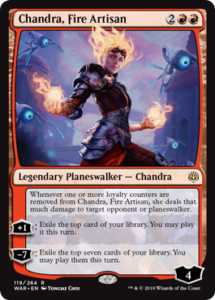
Chandra is a punishing finisher, too. If you let her ultimate, she’ll hit you for seven and draw them a handful of cards for a turn. But any way her counters get removed, you will take damage. Vraska’s Contempt provides a clean answer, but the only popular deck playing that card is Esper, which is already a great matchup for Mono Red.
The format is wide open.
Last weekend began the season of Standard Mythic Championship Qualifiers. From the information I could gather, the following decks won an MCQ and put a player into the Mythic Championship:
- Rakdos Sacrifice
- Azorious Superfriends
- Mono-Red
- Gruul Aggro
- Izzet Phoenix (twice)
- Bant Vannifar
- Jeskai Superfriends
- Bant Flash
- Esper Midrange
Only half of these decks made an impression at SCG Richmond, which suggests an open, developing metagame. Right now, almost anything you can design can win. As long as you put in the effort to learn your deck inside and out—Arena is a great boon in this department—you can do well.
There is definitely a caveat to this though. Surprise can win games, but in larger tournaments with potential scouting, this edge shrinks. Testing will far surpass any theory-crafting about how to outsmart the metagame with a surprise strategy.
Nexus is still everywhere.
In case the above results scared you, don’t worry. Nexus of Fate is still everywhere, tied with being the second-most-represented deck within the Top 16 of the SCG Open, just behind the four copies of Esper variants. Looking further down the standings, Nexus still appears everywhere.
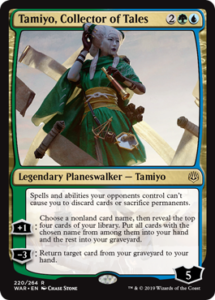
The biggest addition to the deck appears to be Tamiyo, Collector of Tales. While not exactly a win condition for the deck, Tamiyo ends games much more reliably than previous iterations of the deck could manage. With Tamiyo’s plus ability, the potential to find a Nexus of Fate becomes deterministic within a matter of a few turns. Combined with Callous Dismissal, Simic Nexus now provides a realistic way to play Nexus of Fate with a far lesser risk of running out of time—not only paper but online too.
With some minor tuning, I would expect to see a lot more Nexus of Fate decks appearing at the top tables of Standard Events everywhere until the card’s rotation later this year.
The third color is either free or not at all.
Browsing the Magic online decklists alongside the SCG Open, there appears to be a running theme. All of the posted decks are either mono-colored (with Mono White, Mono Red and even Mono Green putting up results) or are three-color midrange decks. With the shockland and checkland manabase in Standard, the deckbuilding cost of adding a third colour is close to minimal.
We’ve seen Golgari slowly adapt and change itself into Sultai to incorporate Hydroid Krasis, Dimir turn into Esper or Grixis, and we’ve already seen Bant have some success so far. That isn’t to say that two-color decks cannot succeed, but you need a good reason to play only two colors. That could be the inclusion of utility lands, such as Blast Zone or Field of Ruin, or the inclusion of hard-to-cast permanents such as Feather, the Redeemed or Niv-Mizzet, Parun.
The premier aggressive decks of the format are still mainly mono-colored, favoring consistency over expanded options. While there are variations of the mono-color decks that include splashes of a second color—Heroic Reinforcements or Teferi, Time Raveler in Mono White, Cindervines in the sideboard of Mono Red—each of these decks are streamlined for their purpose of winning the game as quickly as they can. Any turns taken off because of mana issues are turns when your opponent can take control of the game.
Play these cards.
With all of this in mind, lets take a look at some of the cards that have gained the most from the addition of War of the Spark!
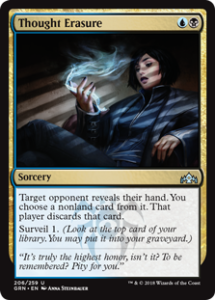
Esper Control appears to be the definitive control deck in this format, and it’s thanks to cards like Teferi, Time Raveler. If you happened to watch any of the coverage this weekend, the new Teferi looks like it has the potential to be a format-defining card. One common line of play involved using Teferi’s static ability to cast Thought Erasure during your opponent’s draw step. It’s hard to come back from that sort of lock.
Thought Erasure retain value in the later stages of the game, when both players are playing off the top of the deck. In previous Standard formats, Surveil 1 for two mana would be a wasted card. But with Teferi, Thought Erasure removes any non-land cr they draw. Get used to seeing this interaction for the next twelve or so months!
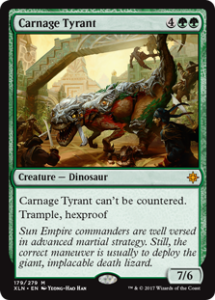
Now, this is hypothetical rather than actual so far, but the number of Carnage Tyrants in Standard is currently at an all-time low. They used to run rampant, but the slow decline of control decks and emergence of cheap, aggressive decks has put the dinosaur on the fringe.
Now that Control decks are starting to retake the lion’s share of the metagame, we should revisit the available control hosers. There is none better than Carnage Tyrant. Could we see an influx of GBx decks due to the death lizard?
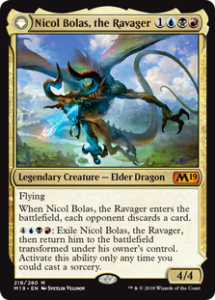
Grixis decks are looking like Bolas tribal. Going all the way back with Nicol Bolas, the Ravager, Bolas has always been a powerful tool but has struggled to make an impact in Standard. That was partly due to the dominance of Teferi, Hero of Dominaria across multiple formats. But Grixis as a color combination was particularly weak before War of the the Spark.
Zack Kanner set out to change the Grixis narrative last weekend, elevating Bolas to his ultimate form as Nicol Bolas, Dragon-God. We should start to see a lot more of our arch villain in play.
Personally, I’m looking to see if there is finally room for Merfolk to become the premier tempo deck of the format and take Mono Blue’s place. Ral, Storm’s Conduit has also been surprisingly absent, considering it looked like it would be a key player of the format when paired with Expansion // Explosion. Let me know what decks you expect to break through with the rest of this MCQ season!
Daniel Roberts (@Razoack) is a UK based player writing about all things Standard. Playing since the release of Gatecrash, he loves nothing better than travelling to European GPs with friends and losing in the feature match area. His best record is 12-3 at GP Barcelona 2017, but he’s aiming for that one more win.

